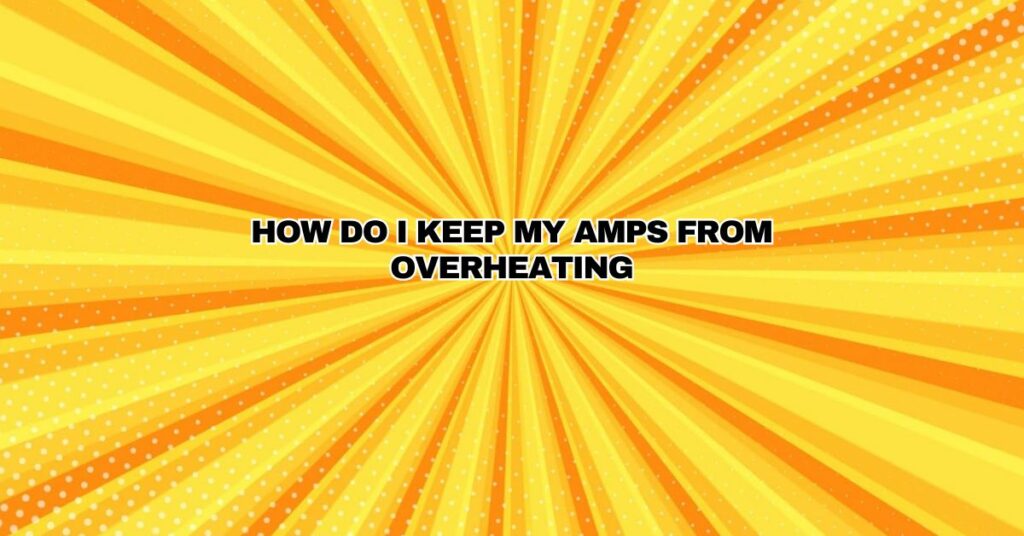Amplifiers are essential components of any guitarist’s rig, and they can generate heat during operation. While some heat generation is normal, overheating can lead to performance issues and even damage to your amplifier. In this comprehensive article, we will explore various tips and techniques for preventing your amp from overheating, whether you’re using a tube amplifier or a solid-state amplifier.
1. Ensure Proper Ventilation:
One of the most critical factors in preventing amp overheating is proper ventilation. Adequate airflow helps dissipate the heat generated by the amplifier’s components. Here are some tips for ensuring proper ventilation:
- Keep the Amp in an Open Space: Avoid placing your amplifier in a confined space where airflow is restricted. It’s best to position the amp in an open area with sufficient room on all sides.
- Leave Space Above and Below: Leave some space above and below the amplifier to allow hot air to rise and dissipate. This is especially important for combo amplifiers, which have the amplifier head and speaker in the same enclosure.
- Don’t Block the Vents: Most amplifiers have ventilation slots or grilles to allow air to flow through. Ensure that these vents are not obstructed by objects or placed against walls.
- Use an Amp Stand: Elevating your amplifier with an amp stand can improve airflow and help keep the amp cooler. Amp stands are particularly useful for combo amplifiers.
2. Avoid High Volume for Extended Periods:
Playing your amplifier at high volumes for extended periods can cause it to generate excessive heat. If you need to play loudly, consider these strategies:
- Take Breaks: If you’re performing or practicing for an extended duration at high volume, give your amplifier short breaks to cool down. This can help prevent overheating.
- Use Attenuators: Attenuators are devices that allow you to reduce the amplifier’s output volume while maintaining the desired tone. They can help you achieve the tone you want without pushing the amp to its limits.
3. Monitor Biasing (Tube Amplifiers):
If you own a tube amplifier, proper biasing of the power tubes is essential to control their operating temperature. Incorrect biasing can lead to overheating and potentially damage the tubes and other components. Here’s what you can do:
- Check Bias Settings: Consult your amp’s manual or a qualified technician to ensure that the power tubes are biased correctly. If your amp has adjustable bias controls, follow the recommended settings.
- Use a Bias Probe: A bias probe allows you to measure the voltage across the output tubes and adjust the bias settings accurately. It’s a valuable tool for maintaining the proper bias.
4. Regular Maintenance:
Routine maintenance can go a long way in preventing amp overheating and ensuring the amplifier’s longevity. Consider these maintenance tasks:
- Clean the Vents: Dust and debris can accumulate in the amplifier’s vents and reduce airflow. Periodically clean these vents to allow better cooling.
- Inspect and Replace Components: Over time, components such as fans and capacitors can wear out. Regularly inspect your amp for any signs of component failure and replace or repair them as needed.
5. Use a Fan (Optional):
In situations where your amplifier is subjected to extended use in a hot environment, using an external fan can help maintain lower operating temperatures. Cooling fans designed for amplifiers are available and can be positioned to blow air over the amplifier’s heatsinks or vents.
6. Be Mindful of the Environment:
The environment in which you use your amplifier can also impact its operating temperature. Consider the following environmental factors:
- Room Temperature: High ambient temperatures can exacerbate overheating. Try to practice or perform in a room with a comfortable temperature. If the environment is hot, be especially cautious about preventing overheating.
- Outdoor Performances: If you’re playing outdoors in direct sunlight, shield your amplifier from direct exposure to the sun. The combination of external heat and amp-generated heat can lead to overheating.
7. Consult a Qualified Technician:
If you notice your amplifier running unusually hot, particularly in situations where it shouldn’t, it may be indicative of a malfunction or component issue. In such cases, it’s advisable to consult a qualified technician to diagnose the problem and perform necessary repairs or adjustments.
Conclusion:
Preventing amp overheating is essential for maintaining the performance and lifespan of your amplifier. Proper ventilation, monitoring bias settings (for tube amplifiers), avoiding prolonged high-volume use, and routine maintenance are key practices to ensure your amplifier operates at a safe and optimal temperature. By following these tips and being mindful of the environment and usage, you can enjoy your amplifier without the worry of overheating issues. If you suspect a problem, don’t hesitate to seek professional assistance to address it promptly and effectively.


